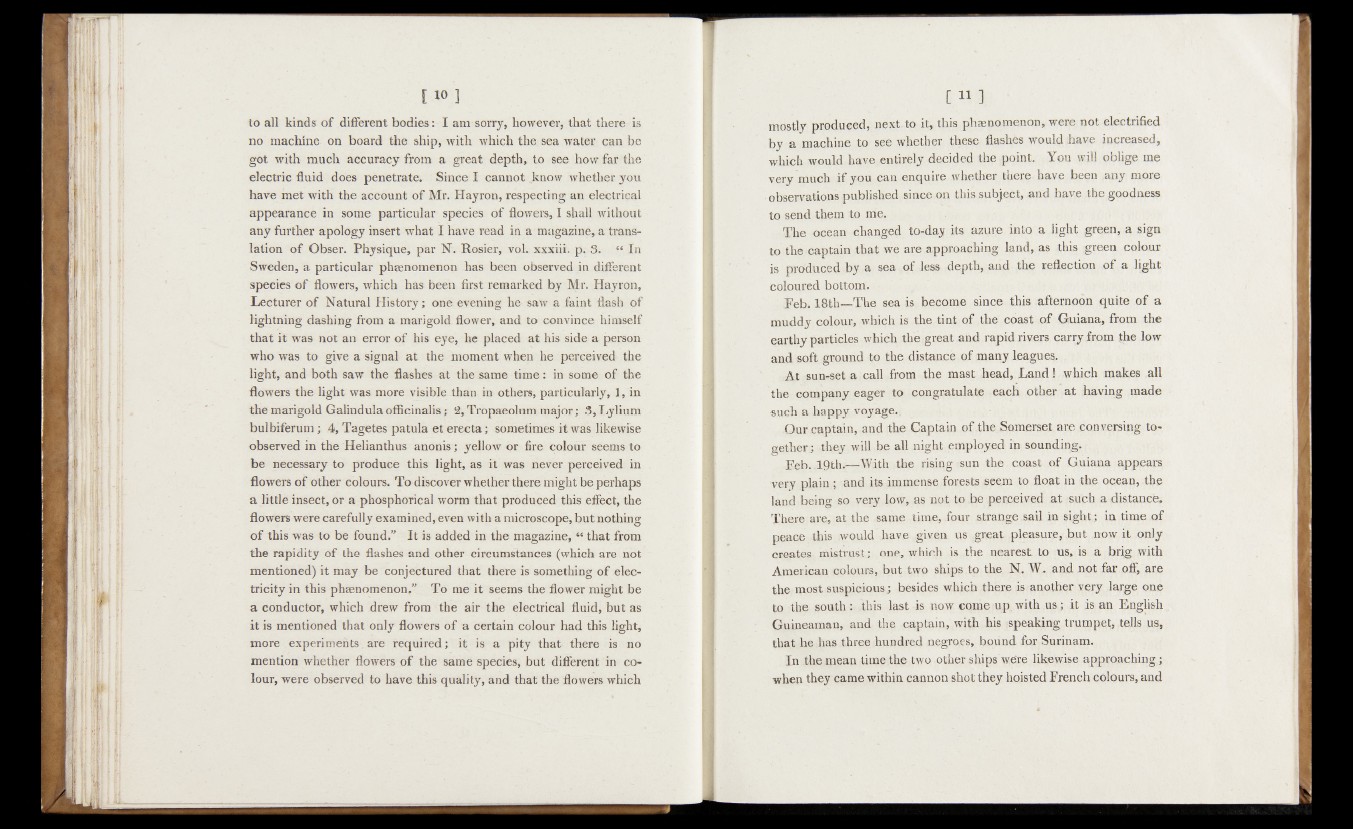
to all kinds of different bodies: I am sorry, however, that there is
no machine on board the ship, with which the sea water can be
got with much accuracy from a great depth, to see how far the
electric fluid does penetrate. Since I cannot „know whether you
have met with the account of Mr. Hayron, respecting an electrical
appearance in some particular species of flowers, I shall without
any further apology insert what I have read in a magazine, a translation
of Obser. Physique, par N. Rosier, vok xxxiii. p. 3. “ In
Sweden, a particular phenomenon has been observed in different
species of flowers, which has been first remarked by Mr. Hayron,
Lecturer of Natural History; one evening he saw a faint flash of
lightning dashing from a marigold flower, and to convince himself
that it was not an error of his eye, he placed at his side a person
who was to give a signal at the moment when he perceived the
light, and both saw the flashes at the same time: in some of the
flowers the light was more visible than in others, particularly, 1, in
the marigold Galindula officinalis; 2, Tropaeolum major; 3, Lylium
bulbiferum; .4, Tagetes patula et erecta; sometimes it was likewise
observed in the Helianthus anon is; yellow or fire colour seems to
be necessary to produce this light, as it was never perceived in
flowers of other colours. Todiscover whetherthere; might beperhaps
a little insect, or a phosphorical worm that produced this effect, the
flowers were carefully examined, even with a microscope, but nothing
of this was to be found.” It is added in the magazine, « that from
the rapidity of the flashes and other circumstances (which are not
mentioned) it may be conjectured that there is something of electricity
in this phenomenon,” To me it seems the flower might be
a conductor, which drew from the air the electrical fluid, but as
it is mentioned that only flowers of a certain colour had this light,
more experiments.are required; it is a pity that there is no
mention whether flowers of the same species, but different in colour,
were observed to have this quality, and that the flowers which
mostly produced, nextto it, this phænomenon, were not electrified
by a machine to see whether these flashès would ihave increased,
Which would hav.e ,entirely decided the .point. You will oblige me
very much if you can enquire whether there have been any more
observations published since on this .subject, and have the goodness
to send them to me. ,
The ocean changed to-day its azure into a light green, a sign
to the captain that we are approaching land, as this green, colour
is produced by a sea . of less depth, and the reflection of a light
Coloured bottom.
Feb. 18th—The sea is become since this afternoon quite of a
muddy colour, which is the tint of ,the coast of Guiana, from the
earthy particles .which the .great and rapid rivers carry from the low
and soft ground to the distance of many leagues. .
At ;sun-rset a call from the mast head, Land i which makes all
the company eager to congratulate each other at having made
•such a happy voyage..
.G u r .captain, and the Captain o f .the^Somerset, are conversing together;;
-they will be all night employed in soundiqg. ;.
Feb. .19th.—-With the rising ?sun the coast of Guiana appears
very plain ; and its immense forests,seem to float in the ocean, the
land being so very low, as not to .be perceived a t «such a distance.
There are, làt; the same time, four .strange .sail in sight.; in time of
peace this iwould .hav.e given us great pleasure, but .now it only
creates mi$tr,us.t;; one, which is .the nearest to us,, is a hrig with
American colours, but two ships to the N, W, and not far oft are
the most suspicious ; besides whjch . there is .another very .large one
to the south : this last is now come‘up, with us ; it is an English
Guineaman, and the captain, with his ispeaking trumpet, tells us,
that he ,has three hundred negroes, bound for Surinam.
In the mean time the two other ships were likewise approaching.;
when they came within cannon shot they hoisted French colours, and